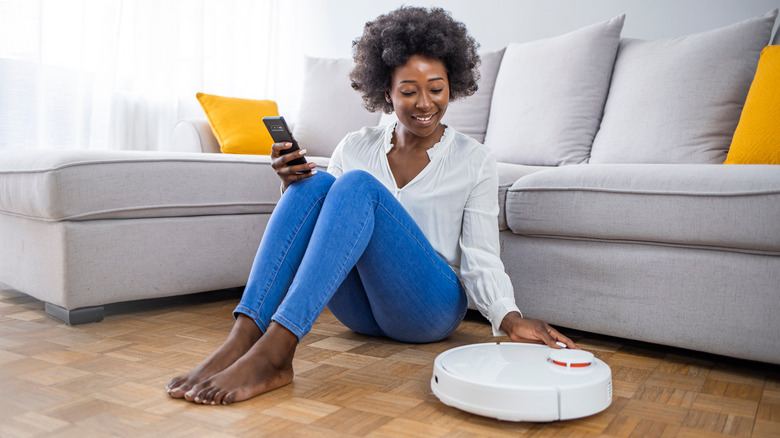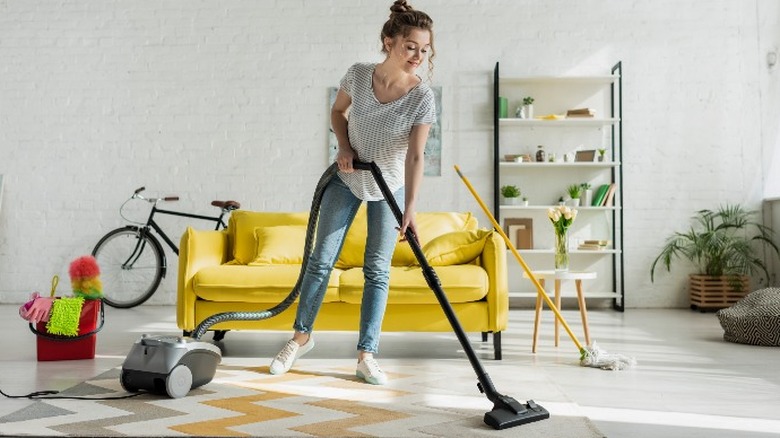The Hidden Downsides To Robot Vacuums
Robot vacuums can save you time and energy by cleaning your floors while you're away from home or relaxing on the couch. As explained in Science ABC, robot vacuums utilize wall sensors, obstacle sensors, and cliff sensors to navigate independently throughout your living space. As they roam, the robots employ rotating brushes and suction to accomplish the task of cleaning your floors. When they finish, these smart appliances return to their docking stations without human help.
However, robot vacuums do not work as completely autonomous units. They require human attention and pose a few real-life application problems. For example, the owner/operators must perform maintenance on the machines, the floor space should be free of clutter, and the robots' small dustbins must be emptied frequently. As with any major purchase, it's helpful to understand the disadvantages as well as the advantages of using the product. Therefore, before investing, you may want to consider the hidden downsides to robot vacuums.
Robot vacuums can be expensive
Compared to traditional upright and canister vacuums, robotic models represent a major household investment. According to CostHelper, the most economical robot vacuums range in price from $200 to $400. However, it's easy to spend over $1,000 if you're looking for top-of-the-line features. Additionally, shoppers should factor in the costs of replacing the batteries, filters, bumpers, and charging stations that robot vacuums require during their functional lifespans. When a decent stick or canister model can be purchased for $100 or less, it's worthwhile to investigate the desirability of a more expensive robot vacuum.
According to Make Use Of, the high-tech components that go into robot vacuums make them costly to manufacture. The inclusion of "sensors, computer brains, and a complicated cleaning system" makes a robot vacuum more expensive than a standard, manually operated model. Of course, the cost of expensive components is passed on to the consumer. Therefore, owners of these appliances pay a significant price for their convenience and time-saving advantages.
Robot vacuums require regular maintenance and cleaning
It's a mistake to think that robot vacuums are completely hands-off. You'll need to perform regular maintenance to keep them in good working order. Wired notes that maintenance goes far beyond simply emptying the dustbin. Instead, you often need to unscrew the rollers for cleaning, unspool the hair that catches in the rotating brushes, and gently clean the plastic covers. On top of that, you might need to replace the brushes and filters, dust any built-up grime, as well as clean the metal contacts in the charging station.
Better Homes and Gardens explains a number of additional chores that will keep your robot vacuum in good working order. These include wiping out the interior of the dustbin, using a standard vacuum to clean the robot's filter, and cleaning the sensors with a damp, microfiber cloth. You can also remove debris from the wheels with tweezers and wipe both the wheels and the ports on the bottom of the vacuum with a microfiber cloth.
You'll still need to deep clean
Although robot vacuums do a good job of routine cleaning on hard-surface floors, they don't perform the deep-cleaning jobs that keep your home fresh and well-maintained. You'll still need to attend to certain manual cleaning chores. According to Consumer Reports, you'll want to keep a traditional upright or canister vacuum on hand for deep cleaning. This is especially true for carpeted areas as well as rugs. Of course, maintaining and storing a traditional vacuum for deep cleaning partially defeats the purpose of having a robot vacuum.
The Chicago Tribune points out that robot vacuums do not have the strong suction power of traditional, manually operated models. While the robot can tackle minor day-to-day cleaning, you can accomplish the deep-cleaning tasks in occasional sessions with a conventional vacuum. In addition to deep-cleaning your carpets, this approach allows you to tackle dirt and dust in places the smart appliance may not have reached.
Robot vacuums are not the best for multi-level living spaces
Robot vacuums have sensors for navigating throughout your home on one level. However, they simply do not do stairs. As explained by Reliance Digital, each robot vacuum includes cliff sensors on its underside. These sensors measure the distance between the unit and the floor via infrared signals. When the robot senses it reached a step or a drop-off, it turns away. Although the cliff sensors provide an ingenious safety function, the robot cannot climb stairs or maneuver from one home level to another.
To remedy this, Gadget Review suggests buying a robot vacuum for each level of your home. Of course, this solution involves the additional cost of purchasing extra units. An alternative might be to manually move the vacuum from one floor of your home to another. But this plan requires time and effort. It also raises the question of how the robot might return to its docking station (assuming the station is on a different level of your living space).
Pet hair may overwhelm your robot vacuum
For many consumers, the daily task of removing pet hair from floors becomes the prime reason for purchasing a robot vacuum. Numerous models available on today's market advertise their ability to collect pet hair and keep floors neat. But while smart vacuums do a good job removing modest amounts of pet hair, they may not be up to the task in homes with multiple pets. This is an especially important consideration for pet parents of long-haired dogs and cats.
Although a roaming vacuum helps to keep the amount of dander and hair to a minimum, it should be considered a stop-gap measure between regular cleanings with a traditional vacuum, as per Consumer Reports. An upright or canister vacuum provides the powerful suction needed to remove stray hair from your floors and carpets thoroughly. This might be disappointing for some, but you can cut down on your daily chores by following the advice of Reviewed and purchasing a self-emptying unit. This type of robot vacuum empties its debris into a separate dust bag at the docking station. You'll still need to remove the bag from the dustbin and dispose of it, but this type of cleaner may hold up better than others when collecting large amounts of pet hair.
Robot vacuums don't like deep pile carpets and carpet fringe
Although robot vacuums perform well on hard-surface floors, they are not an optimal choice for carpeted areas. This is especially true of deep-pile or shag carpets as well as rugs with fringed edges. Robot vacuums have improved over the past 20 years, and many models advertise their effectiveness on carpets. However, they still do not demonstrate the power and maneuverability to thoroughly clean deep-pile options. Additionally, consumers may need to pay high prices for advanced models to acquire robot vacuums that effectively clean carpeted surfaces.
According to Cleaners Talk, even the high-priced, advanced smart vacuums work better on low-to-medium pile carpets rather than deep-pile floor coverings. When compared with traditional, manually operated vacuums, robotic models come up short on carpet-cleaning tasks. They simply do not exert sufficient suction for deep cleaning. Additionally, the fringe found along the edges of some rugs can become entangled in the robot vacuum's brushes and wheels, bringing the unit to a stop. To keep the robot vacuum off your carpets, CNET recommends rolling up the rug's edges before a cleaning session. But you'll need to come back later with an upright or canister vacuum to finish your cleaning chores.
Robot vacuums become ensnared in electrical cords and long curtains
Your robot vacuum's sensing system will not protect it from becoming entrapped in tangled electrical cords around your home. According to Digital Trends, a robot vacuum utilizes light detection and mapping systems for navigating. These systems protect the device from colliding with obstacles as it roams throughout your living space. However, while these navigation systems allow the robot to maneuver around an object like the leg of a chair, they may not sense electrical wires running along the floor. With the multitude of electrical and charging wires that we use in our modern homes, it's easy for the vacuums to become entangled. One solution is pre-cleaning the area by picking up wires before the device makes its run. However, you may not have time for a pre-cleaning session in preparation for each foray of your robot vacuum.
As noted in PCMag, long curtains pose a similar threat to robot vacuums. The sensors on the robots do not detect the curtains in the way that they sense solid objects such as furniture and walls. Therefore, those gorgeous window treatments that pool on the floor will act like snares for the unsuspecting vacuums.
Toys and small objects lying on the floor can derail it
Owners of robot vacuums find that they must pre-clean their floors before the handy device roams throughout the space. For proper functioning, it needs a clear floor space devoid of clutter. This consideration may be of special interest in households where children and pets reside. Although a few advanced models feature obstacle avoidance that allows them to maneuver around small objects like socks and toys, most robot vacuums do not have that capability (via TechRadar). Additionally, it may be necessary to pay a higher price if you're looking for an advanced model that offers obstacle avoidance technology.
Robot vacuums without the high-tech sensing capability have been known to eat socks, shoelaces, and other small objects lying on the floor. As it ingests the object, the machine becomes clogged and may be permanently damaged. To avoid this, Smart Robot Reviews explains that consumers might search for robot vacuums with cameras or 3D sensors in addition to the typical Lidar and VSlam navigation systems. The newer object-recognition technology helps robot vacuums avoid small objects on floors.
Some messes are too much for robot vacuums
Many robot vacuums simply do not have sufficient suction to clean significant dirt and grime from floors and carpets. According to Choice, robot vacuums do not have the suction power of traditional models because their motors are smaller. Additionally, the robots' brushes do not agitate surfaces as vigorously as regular vacuums, and their dust receptacles are smaller. Consumers might consider the amount of dirt that gets tracked onto their floors by the adults, children, and pets who occupy the living space. However, using a robot vacuum might be a handy way to top off the floor-cleaning chores between sessions with a traditional vacuum.
Some messes are even yuckier than tracked-in mud from the garden. Therefore, horror stories circulate among dog owners who use robot vacuums. Apparently, the navigation systems of the robots cannot sense the dog poop, and they will roll right over it. Of course, this results in a horrific scene of smeared poop across your floors and carpets. Wirecutter calls this occurrence a "turdpocalypse." Dog owners might consider how often Fido doesn't quite make it outdoors before they decide to purchase a robot vacuum.
They can get stuck going under or over solid obstacles
Built-in sensors enable robot vacuums to maneuver throughout your living space. But they can get stuck under furniture and cabinets or when traveling over tall thresholds. Most robot vacuums measure approximately 3.8 inches in height from the floor, as per LIve Lavish Life. Therefore, they have no problem navigating under tables and dining chairs, but they might get stuck when maneuvering under low-to-the-floor furniture. Sofas, hutches, and the toe-kick space of lower kitchen cabinets may become traps for them. You can try workarounds such as placing furniture pieces on risers and adding bumper extenders to the robots or pool noodles to the edges of rugs. These solutions allow the robots to travel under furniture, or they simply cause the units to turn away from potential hazards.
In addition to getting stuck under furniture and cabinets, robot vacuums can become immobilized while attempting to roll over solid obstacles. Thresholds in doorways pose a particular hazard. According to AI Time Journal, many (but not all) robot vacuums can handle a vertical climb of ¾ inch, and most premium models can maneuver over low thresholds. However, higher thresholds are insurmountable. To avoid potential problems, consumers might measure the thresholds in their living spaces and search for robot vacuums that can roll over them.
Your pet might hate your robot vacuum
Many people share their living spaces with furry friends. In fact, the challenge of maintaining a clean home environment while parenting indoor pets may motivate consumers to purchase a robot vacuum. However, some pets might perceive the robot as a threat. Although watching videos of cats and dogs riding robot vacuums is fun, the reality is that many pets are frightened and confused by them. Mental Floss explains it from the pet's point of view. The robot smells like an object but moves like a living thing. On top of that, it makes noise. If you buy one, be prepared to provide reassurance and training to help your furry friends accept the new interloper in their living space.
In some cases, dogs are so upset by the noise and movement of the robot vacuum that they bark and try to bite it. Mi Dog Guide offers suggestions for desensitizing your dog to the device. First, introduce the robot to the dog while it is turned off and place a treat on top of the unit. Praise the dog for approaching the new machine and accepting the treat. Gradually, over time, the dog will become accustomed to the turned-off robot's presence in their living space. Then, it's time to help the dog accept the noise and movement of the robot vacuum in operation. Please do not leave the room, as the dog needs you to provide reassurance and praise, signaling that it's okay for the vacuum to roam around the space while making noise.
Occasionally it can't find its way home
Robot vacuums are designed to automatically return to their docking stations after cleaning your floors. But MrGadget notes that they occasionally fail to make it back to home base. Although it's rare, they can end up stranded in your living space.
Several problems may arise that leave the robot lost and stranded. The most common reason for stopping and failing to return to the docking station is a low battery. As noted in The Appliances Reviews, most robot vacuums use lithium-ion or lithium-polymer batteries that must be charged in the robot's charging station. If the unit does not return to the station, several problems and solutions may be addressed. The user might clean the contacts to ensure proper charging as well as ensure that the sensors on the robot's bumper are clean.
Additionally, it's necessary to remove the protective film on the infrared panel of the docking station so that it can communicate with the robot. Alternatively, the robot may not sense the location of the docking station because it started from a different point in the room. Finally, the lithium battery may be at the end of its lifespan and need to be replaced after extended use. If a low battery is not the cause of the robot becoming stranded, the problem may lie in the location of the docking station. The station must be installed where the robot can find it. Keep all obstacles away from the docking station within a radius of at least 20 inches.
Consumers might weigh the convenience and time-saving benefits of using robot vacuums against the hidden downsides. After considering both the advantages and disadvantages, you can decide if a smart vacuum is right for you.












